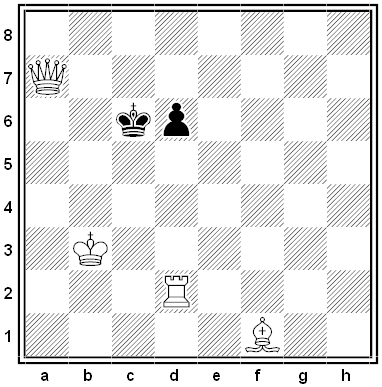
In Two-Move Chess Problems (1986), Robert Moore calls this a “very lightweight jewel.” White to mate in two moves.

In Two-Move Chess Problems (1986), Robert Moore calls this a “very lightweight jewel.” White to mate in two moves.
In Strictly Speaking (1974), Edwin Newman points out that the names of American college presidents are strangely interchangeable: Columbia’s Nicholas Murray Butler would have projected the same impressive dignity if he’d been Nicholas Butler Murray or Butler Nicholas Murray. Kingman Brewster, president of Yale, might as well have been Brewster Kingman. Newman gives five pages of examples, drawn from the 1973 Yearbook of Higher Education:
Brage Golding, California State University
Harris L. Wofford, Jr., Bryn Mawr College
Thurston E. Manning, University of Bridgeport
Gibb Madsen, Hartnell College
Rexer Berndt, Fort Lewis College
Dumont Kenny, Temple Buell College
Woodfin P. Patterson, Jefferson Davis State Junior College
Imon E. Bruce, Southern State College
Cleveland Dennard, Washington Technical Institute
Culbreth Y. Melton, Emmanuel College
Pope A. Duncan, Georgia Southern College
Hudson T. Armerding, Wheaton College
Landrum R. Bolling, Earlham College
Mahlon A. Miller, Union College
Dero G. Downing, Western Kentucky University
Wheeler G. Merriam, Franklin Pierce College
Placidus H. Riley, St. Anselm’s College
Ferrel Heady, University of New Mexico
Lane D. Kilburn, King’s College
Hilton M. Briggs, South Dakota State University
Granville M. Sawyer, Texas Southern University
“Note also that the names are interchangeable up, down, diagonally, taking every other name, every third, fourth, fifth, and so on, at random, and — for parlor game purposes — any other way you can think of. In mixed clusters of three, especially when read or sung aloud, they are often enchanting.”
A New York Times story from 1946 observes that a man named Ole Lee, “after years of struggle,” had arranged to receive the license plate number 337-370.
“It was his name spelled upside down.”
I had my doubts, but here’s a photo.
In 1831, in the appendix to a book on the raising of trees for shipbuilding, Scottish grain merchant Patrick Matthew suggested that, over great expanses of time, “the progeny of the same parents, under great difference of circumstance, might, in several generations, even become distinct species, incapable of co-reproduction.” He’d struck on the central idea of natural selection nearly 30 years before On the Origin of Species:
As the field of existence is limited and pre-occupied, it is only the hardier, more robust, better suited to circumstance individuals, who are able to struggle forward to maturity, these inhabiting only the situations to which they have superior adaptation and greater power of occupancy than any other kind; the weaker, less circumstance-suited, being prematurely destroyed.
On learning of this, Darwin allowed that Matthew “briefly but completely anticipates the theory of Nat. Selection.” In a letter to the Gardeners’ Chronicle, in which Matthew had pointed out his early observation, Darwin wrote, “I freely acknowledge that Mr. Matthew has anticipated by many years the explanation which I have offered of the origin of species, under the name of natural selection.”
But modern observers point out that Matthew didn’t pursue the idea and may not have realized the breadth of its import. Historian of science Peter Bowler writes, “Simple priority is not enough to earn a thinker a place in the history of science: one has to develop the idea and convince others of its value to make a real contribution.” Darwin called Matthew’s note “a complete but not developed anticipation … Anyhow one may be excused in not having discovered the fact in a work on Naval Timber.”

Among electric fish, those that live in freshwater have their generating cells arranged “in series”; in saltwater they appear “in parallel.”
Seawater conducts better than fresh water, so freshwater fish need to generate a high voltage to overcome the resistance of their medium. Their electricity-producing cells are arranged in series.
Marine fish operate at higher currents but lower voltages, so their electrocytes appear in parallel.
William Stokes’ Pictorial Multiplication Table of 1866 promised to teach multiplication facts to a child of average ability in less than half an hour. It did this by representing each digit with an object:
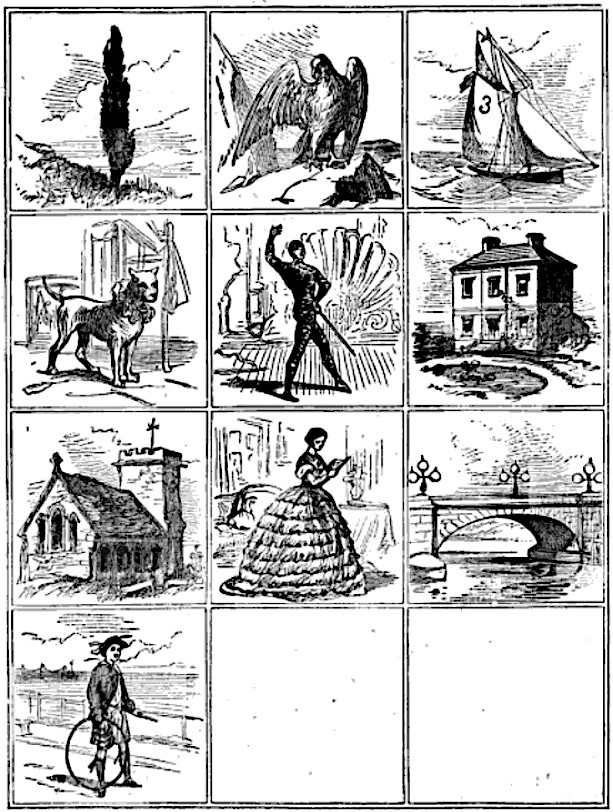
A TREE means 1, from one trunk springs.
A BIRD means 2, it has two wings.
A BOAT is 3, three sails are shown.
ANIMALS 4, four legs they own.
A MAN means 5, five fingers he.
A HOUSE means 6, six windows see.
A CHURCH means 7, not windows less.
A LADY 8, see eight-flounced dress.
A BRIDGE is 9, nine lamps are found.
A BOY means 0, see hoop so round.
Now each fact can be represented by a picture. Here’s the “twice” table:
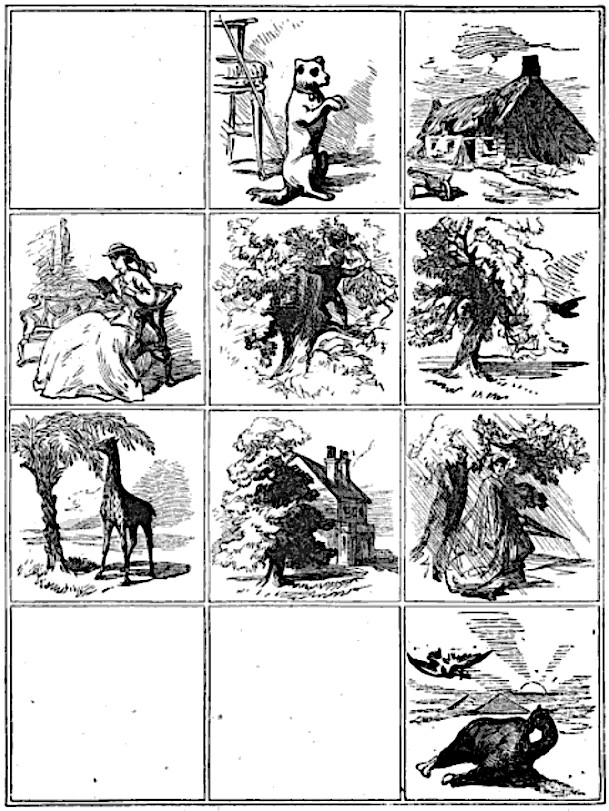
These are the products of 2 with the first 12 integers, in order. The second box, representing 2 × 2, depicts a dog, which is an ANIMAL with 4 legs, so 2 × 2 is 4. The sixth box, representing 2 × 6, depicts a TREE and a BIRD, so 2 × 6 = 12. And so on. The first box, which covers the fact that 2 × 1 = 2, is omitted because we’ve already mastered the fact that 1 × 2 = 2 (in the “once” table). The 10th and 11th boxes are blank because multiplication by 10 and 11 are considered so easy that no mnemonic is needed.
How can we remember the “twice” table itself? Stokes provides a verbal rhyme that sums it up:
Twice — Dog, Cot, Reader, Nest, and Bird flying;
Giraffe, Inn, Shower, and Camel dying.
In this way a student can master every fact up to 12 × 12 by memorizing 59 simple pictures (and 12 rhymes). How well this worked, and whether the images could be carried accurately in one’s head through a lifetime, is less clear.
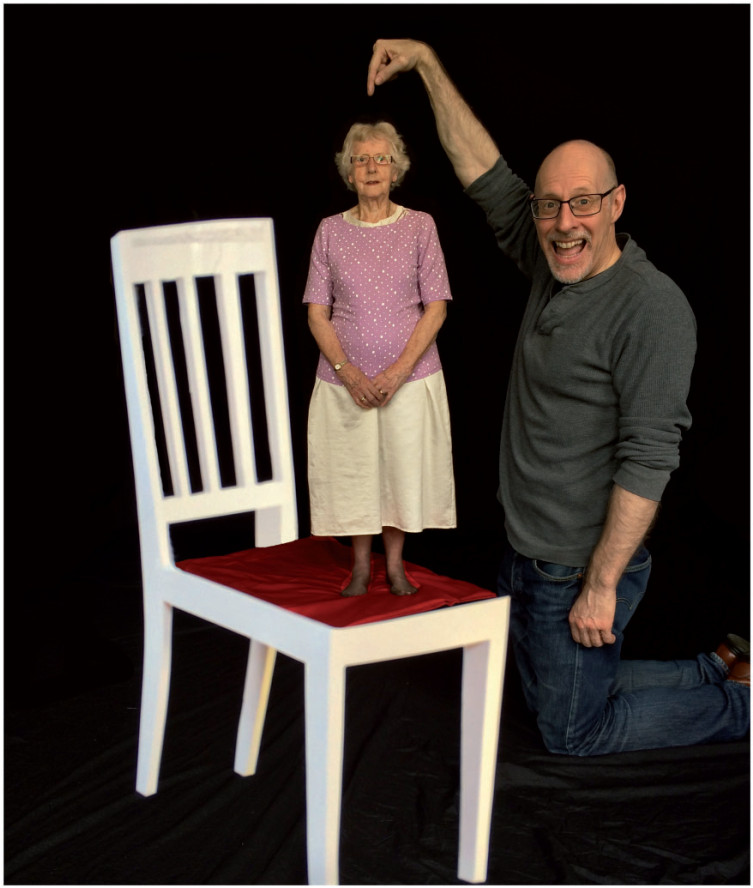
Using a cardboard template, a cloth, and a tripod, psychologist Richard Wiseman found a way to make ordinary people tiny.
The illusion is an improvement on a technique pioneered by Jean Beuchet in the 1960s. More at the link below.
(Richard Wiseman, “A New Version of the Beuchet Chair Illusion,” i-Perception 7:6 [November-December 2016], 2041669516679168.)
By philosopher Steven M. Cahn:
(1) Assume that there exists an omnipotent, omniscient, omnimalevolent Demon who created the world.
(2) If the Demon exists, then there would be no goodness in the world.
(3) But there is goodness in the world.
(4) Therefore, the Demon does not exist.
A demonist who wants to deny (4) would need to deny (1), (2), or (3). No demonist would question (1), and it’s difficult to deny (3), but we can escape (2) only by claiming that the world’s good is somehow necessary, that every good in the world is logically needed in order for this to be the worst world that the Demon could have created.
This is the familiar “problem of evil” turned on its head. The notion that all the world’s good (sunsets, Socrates’ free will) is necessary to create maximum evil is just as improbable as that all the world’s evil (bubonic plague, Hitler’s free will) is needed to create maximum good. Unless demonists or theists can produce further evidence in favor of their positions, “the reasonable conclusion is that neither the Demon nor God exists.”
(Steven M. Cahn, “Cacodaemony,” Analysis 37:2 [January 1977], 69-73.)
The English name for 13,000,000,000,000,000,003,019,000,000,000, THIRTEEN NONILLION THREE TRILLION NINETEEN BILLION, is spelled with 1 B, 2 Hs, 3 Rs, 4 Os, 5 Ts, 6 Ls, 7 Es, 8 Is, and 9 Ns.
(Thanks, David.)
On a glass door in the mathematics department at the University of Erlangen–Nürnberg in Germany, this determinant is printed:
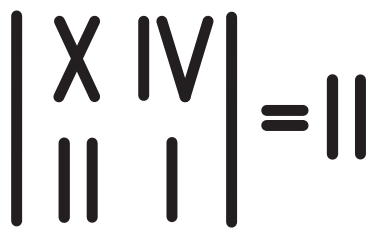
Sure enough, X · I – IV · II = II.
Pass through the door and regard it from the other side and you see a different equation:
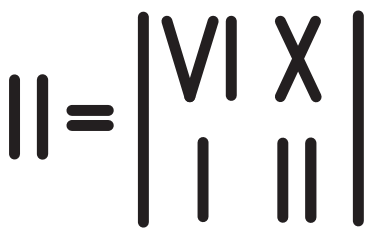
But this too is true: II = VI · II – X · I.
(Burkard Polster, “Mathemagical Ambigrams,” Proceedings of the Mathematics and Art Conference, 2000.)